Rewatching The Crucible in the Moment of #MeToo
It's time to rethink our metaphors.
This is not the Crucible essay I thought I would write.
I loved The Crucible as a teenager (the 1996 Daniel Day Lewis version, obviously). Every Friday from the age of sixteen to eighteen, I came home from field hockey practice, kicked off my cleats, hurled myself onto our scratchy mushroom-brown floral couch and began my private Sabbath ritual of rereading one of my three favorite books — Lolita, The Catcher in the Rye, or Arthur Miller’s script. I thrilled when I reached the climactic pages where the hero, John Proctor, snatches his signed confession from the Salem judges and demands, “is there no good penitence but it be public?!” I exulted when he turns to his wife, estranged no longer, kisses her savagely and implores her, “Show a stony heart and sink them with it!” And even now, as a much more cynical adult, I tear up as Elizabeth Proctor watches her husband carted off to his execution and waves aside all attempts to persuade him to recant with the sad, proud remark, “He have his goodness now. God forbid I take it from him.”
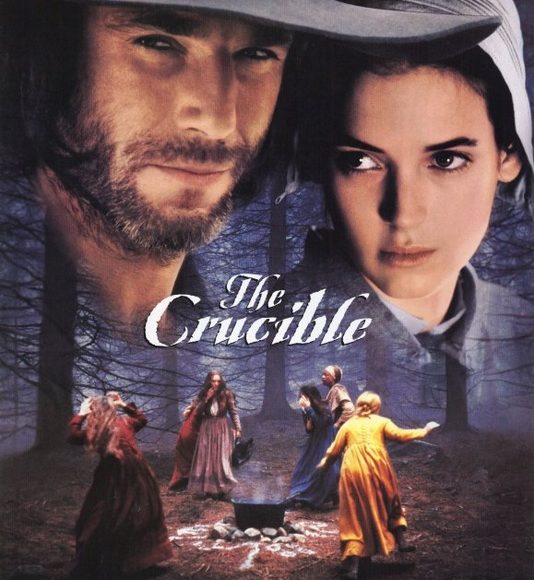 But about halfway through watching it last month, I turned to my husband, stretched out on our ratty black futon next to me, and voiced the thought that had been building for an hour. “Maybe this whole witch hunt never would have happened if John Proctor had stopped beating the everliving shit out of all of the teenaged girls who worked for him.”
But about halfway through watching it last month, I turned to my husband, stretched out on our ratty black futon next to me, and voiced the thought that had been building for an hour. “Maybe this whole witch hunt never would have happened if John Proctor had stopped beating the everliving shit out of all of the teenaged girls who worked for him.”
We are in a collective cultural moment when the rhetoric of “witch hunts” is being bandied about to describe the mass firings of famous men accused of sexual assault. Ladled down our collective throats as an allegory for McCarthyism in high school, recently revived to rapturous acclaim on Broadway, and personally beloved as a nostalgic object of my adolescence, The Crucible, I thought, was the perfect vehicle for thinking about the strange twists in American consciousness that made it possible to talk about the reckoning visited on Louis C.K., one of the most powerful men in Hollywood, as if he were an illiterate Puritan peasant woman tortured for selling strange herbs.
And it is. But it is also a movie about how if you beat your domestic worker long and hard enough, she will sell you out as a warlock who stops her breath and interrupts her sleep with night terrors to the first angry mob that comes by. In that respect, the movie may have some problems, but it is a better allegory than Arthur Miller could have planned.
***
It takes a certain willful perversity to turn witch hunts – a form of persecution famous for targeting marginalized women – into a tragic story about how a wealthy male landowner is destroyed when his own unyielding principles collide with the vengeance of a lustful schoolgirl. It was not strictly wrong of Miller to focus Salem on the story of a man, of course. John Proctor was a real man who was hanged during the Salem witch trials, though he was sixty and his seductress in the play, Abigail Williams, was in reality twelve, and the accusing children were all female. Still, even Salem was a much smaller and much more female affair than the playwright makes it seem. Only five of the executed were men; the other fourteen were women.
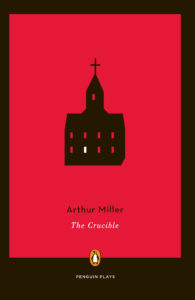 Curiously, this rather obvious point was not one of the objections that Miller bothered to address in interviews he gave in the years following The Crucible’s 1953 debut. The story he consistently gave was the one many of us are familiar with from high school English: the play was born out of McCarthyism and the Red Scare.
Curiously, this rather obvious point was not one of the objections that Miller bothered to address in interviews he gave in the years following The Crucible’s 1953 debut. The story he consistently gave was the one many of us are familiar with from high school English: the play was born out of McCarthyism and the Red Scare.
At first, Miller was oblivious to the rising the anti-communist fervor surrounding him. Most of the people he knew in Hollywood were socialists or communists of some sort. He himself had attended a few communist meetings in a desultory way. It seemed impossible to imagine Hollywood turning on everyone who had expressed sympathy with the Left. Who would be left to write movies?
He only began to suspect the gravity of the threat when it came time to turn The Death of a Salesman into a movie. The play had been widely acclaimed as the poignant story of one man’s breakdown as he confronts the impossibility of realizing the American Dream. After the bidding war that ensued among the major studios for adaptation rights, he was wholly unprepared for the flurry of panicked requests his producers at Columbia Studio sent his way. Would Miller sign an anti-Communist pledge? What about softening the message to placate the American Legion, which was threatening to picket the movie as un-American? Could he at least try writing something about America that was less…depressing?
Irritated, Miller refused all of their requests. In return, he relates in a 2000 interview:
The studio actually made another film, a short to be shown with Salesman. This was called The Life of a Salesman and consisted of several lectures by City College School of Business professors – which boiled down to selling was a joy, one of the most gratifying and useful professions, and that Willy was simply a nut. Never in show-business history has a studio spent so much good money to prove that its feature film was pointless.
Hollywood’s efforts to distance itself from Miller became decidedly less darkly comical in future years. He lost contracts, friends, audiences, years of his creative life. He was called before the House of Un-American Activities (HUAC) for his refusal to name other writers as communists, though offered a pass if his wife, Marilyn Monroe, would consent to have her picture taken with the Chairman of the Committee. Miller refused.
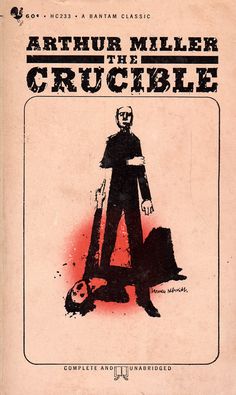 Instead, he began writing The Crucible. In the years to come, Miller would face accusations that he had conflated the imaginary crime of witchcraft with the real crime of communism. He shrugged off the accusations as besides the point. Both communists and witches had seemed real to the societies bent on ferreting them out. And, anyway, even the communists who did exist in Hollywood were certainly not the threat they were made out to be. Mostly, Miller thought, their movies were “silly.” No, the real point of The Crucible, for Miller, was that it “became awesome evidence of the power of human imagination inflamed, the poetry of suggestion, and the tragedy of heroic resistance to a society possessed to the point of ruin.”
Instead, he began writing The Crucible. In the years to come, Miller would face accusations that he had conflated the imaginary crime of witchcraft with the real crime of communism. He shrugged off the accusations as besides the point. Both communists and witches had seemed real to the societies bent on ferreting them out. And, anyway, even the communists who did exist in Hollywood were certainly not the threat they were made out to be. Mostly, Miller thought, their movies were “silly.” No, the real point of The Crucible, for Miller, was that it “became awesome evidence of the power of human imagination inflamed, the poetry of suggestion, and the tragedy of heroic resistance to a society possessed to the point of ruin.”
And now, some version of Miller’s story – with its conflation of witches and communists, petty sexual vengeance and politic persecution, accusations and self-interest – whispers beneath every conversation in which #MeToo is called a witch hunt. In that respect, Arthur Miller did something remarkable. In writing The Crucible, he did more than produce a great work of art. He changed history. He changed our collective memories about what Salem meant. He gave us a vocabulary for talking about moments of mass uncertainty and ad hoc justice that has become a shorthand for rightful, righteous suspicion of our own Puritanical past.
It just so happens that the vocabulary he gave us was misogynistic.
***
To be even blunter: The Crucible is breathtakingly misogynistic. It reduces the whole tragic mess to the calculating sexual jealousy of a teenage girl who was happy to watch her neighbors hang if it meant she might one day resume her adulterous affair with her former employer. It’s Fatal Attraction with buckled hats. It even goes so far as to suggest that witchcraft is real, in a way, and it is being practiced by the silly teenaged girls who accuse everyone in their paths in order to deflect attention from themselves.
 In its single-minded focus on the dangers of a jealous woman, the play misses the real cause of John Proctor’s downfall. John Proctor does not hang because he slept with the wrong woman. Abigail Williams, after all, confesses in a farewell scene that she never meant for him to be harmed. John Proctor hangs because his current servant, Mary Warren, accuses him of witchcraft to save her own life. And why wouldn’t she? Proctor spends the entire play beating her and berating her. Whatever begrudging loyalty she felt to the man and his wife that drove her attempt to unmask the girls of the village as “pretending” crumples the minute she is forced to choose between her life and his. We are meant to think that Mary Warren is well-meaning but weak and Proctor’s downfall comes from a tragic collision of events. What we are not meant to wonder is whether Proctor’s real sin might not be in his thoughtless participation in a social system that makes it acceptable to beat your servants but not your wife.
In its single-minded focus on the dangers of a jealous woman, the play misses the real cause of John Proctor’s downfall. John Proctor does not hang because he slept with the wrong woman. Abigail Williams, after all, confesses in a farewell scene that she never meant for him to be harmed. John Proctor hangs because his current servant, Mary Warren, accuses him of witchcraft to save her own life. And why wouldn’t she? Proctor spends the entire play beating her and berating her. Whatever begrudging loyalty she felt to the man and his wife that drove her attempt to unmask the girls of the village as “pretending” crumples the minute she is forced to choose between her life and his. We are meant to think that Mary Warren is well-meaning but weak and Proctor’s downfall comes from a tragic collision of events. What we are not meant to wonder is whether Proctor’s real sin might not be in his thoughtless participation in a social system that makes it acceptable to beat your servants but not your wife.
This dogged refusal to see labor disputes led by women as anything other than an expression of petulance and unruly sexuality is one legacy of The Crucible in our current moment. The unselfconscious willingness to turn the metaphor of a witch hunt against women is another.
Without The Crucible, would we still be willing to rhetorically conflate powerful men accused of well-documented sexual crimes with powerless women persecuted for imaginary crimes? Or women who tell their stories with hysterical villagers waving pitchforks? I suspect we would find some language to discredit women but it is not obvious that this is the metaphor that would be in play. The Crucible might well be a great work of art, but its moral mathematics skew male every time.
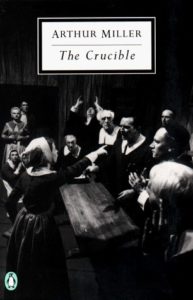 I can hear Miller’s ghostly objection as I write this. I am merely repeating the old blunder of his critics who insisted on drawing literal-minded parallels between Salem and McCarthyism, mistaking the effort to capture an atmosphere with a statement of fact. Perhaps that was once true but the metaphor long ceased being his alone. In the present moment, the true danger of the Salem-McCarthyism allegory isn’t that it confuses imaginary crimes for real ones. The danger is that it suggests that even if the crimes are real, they are treated as though don’t matter terribly much.
I can hear Miller’s ghostly objection as I write this. I am merely repeating the old blunder of his critics who insisted on drawing literal-minded parallels between Salem and McCarthyism, mistaking the effort to capture an atmosphere with a statement of fact. Perhaps that was once true but the metaphor long ceased being his alone. In the present moment, the true danger of the Salem-McCarthyism allegory isn’t that it confuses imaginary crimes for real ones. The danger is that it suggests that even if the crimes are real, they are treated as though don’t matter terribly much.
To call our current reckoning with sexual assault a witch hunt is to assert a position of smug futurity—to say, in effect, that I, unlike all of those swept up in the fervor of this terrible reckoning, can distance myself enough to see that one day we will all look back on this moment in shame. #MeToo, like Salem, like McCarthyism, like the Satanic Panic, will become yet another bead on our national rosary of unreasoning moral panics that we murmur to ourselves in contrition during history class. When that moment finally comes, we will see the true victims were not the accusers but the accused.
But why should that be the case? Why should this vantage point of the future that imagines our moment as a new Salem be right?
Is it because there are a huge number of men being accused? A much larger number of women have been assaulted. And, anyway, I promise you most guilty men will never be held accountable.
Is it because so many women are so angry and so vehement? We have good reason to be angry.
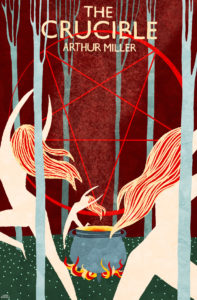 Is it because the question revolves around sex and we Americans have always been puritanical? There are plenty of nuanced conversations happening about how to draw boundaries between flirtation and harassment, but even if there weren’t I refuse to assume this burden. Academia has spent thirty years dismantling appeals to vague national essences; I am not about to accept their use now because it’s politer than calling women who complain about unwanted sexual advances frigid.
Is it because the question revolves around sex and we Americans have always been puritanical? There are plenty of nuanced conversations happening about how to draw boundaries between flirtation and harassment, but even if there weren’t I refuse to assume this burden. Academia has spent thirty years dismantling appeals to vague national essences; I am not about to accept their use now because it’s politer than calling women who complain about unwanted sexual advances frigid.
Is it because it seems frightening, arbitrary, and capricious who is outed and fired? If there are two guilty men and only one is ever punished for his crime, it may be unfair that the first is punished but it is in no way unjust.
Is it because the crimes actually aren’t the same and it seems unfair to lump Louis C.K. in with Matt Lauer and Harvey Weinstein? They all behaved abominably.
All of this is not to say that critics are entirely wrong. It is reasonable and even admirable to be on guard against false accusations and hasty dispensations of justice. But in calling #MeToo a witch hunt, critics are doing more than inserting a cautionary note into a heated conversation. They are actively discrediting women and coopting the history of women’s persecution to insinuate that collective expression of women’s anger must be hysterical. They are dodging the question of whether that anger is justified. The Crucible might be righteous but it is also reactionary.
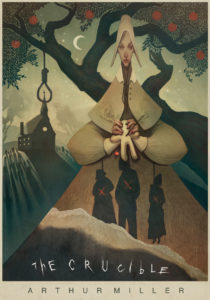 Miller is worth rewatching in this moment because in a tidy two hour and four minute plot, he created a powerful allegory of the way fear, personal interests, and unyielding principles can all combine to grind innocents in the gears of history. But in doing so he also contributed to a culture that has no way of talking about the real dangers of grassroots, ad hoc justice that isn’t either misogynistic or classist. Witch hunts, hysteria, mob justice — these are all just different ways of dismissing large groups of angry people as irrational, dangerous, feral. And that is a problem in a moment there are so very many reasons for large groups of people to be angry, whether that means sexual assault, police brutality, voter disenfranchisement or growing economic inequality.
Miller is worth rewatching in this moment because in a tidy two hour and four minute plot, he created a powerful allegory of the way fear, personal interests, and unyielding principles can all combine to grind innocents in the gears of history. But in doing so he also contributed to a culture that has no way of talking about the real dangers of grassroots, ad hoc justice that isn’t either misogynistic or classist. Witch hunts, hysteria, mob justice — these are all just different ways of dismissing large groups of angry people as irrational, dangerous, feral. And that is a problem in a moment there are so very many reasons for large groups of people to be angry, whether that means sexual assault, police brutality, voter disenfranchisement or growing economic inequality.
People have been shoving back against this language. In a column in the New York Times a few months ago, Lindy West skewered Woody Allen for calling the accusations against Weinstein a new Salem. She wrote, “Setting aside the gendered power differential inherent in real historical witch hunts (pretty sure it wasn’t all the rape victims in Salem getting together to burn the mayor), and the pathetic gall of men feeling hunted after millenniums of treating women like prey, I will let you guys have this one. Sure, if you insist, it’s a witch hunt. I’m a witch, and I’m hunting you.” The column is funny, trenchant, and cathartic. It is also, I hope, a sign that this old, tired, fraught, unutterably stupid rhetoric might be coming to an end in order to make space for new language that does not carry its conclusions in its metaphors.
***
Liane F. Carlson is Stewart Postdoctoral Fellow and Lecturer in Religion at Princeton University. She received her PhD in philosophy of religion from Columbia University in 2015. Her research interests include continental philosophy, with emphasis on theories of religion, embodiment, evil, and the intersection of religion and literature.
***
Published with support from the Henry R. Luce Initiative on Religion in International Affairs.